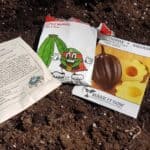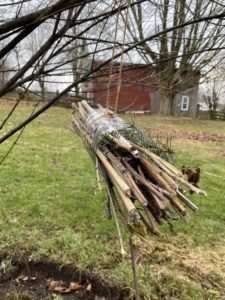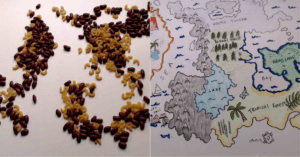Introduction
We will be exploring sustainable polyculture crop production systems by learning how to plant a traditional Haudenosaunee Kionhekwa, or Three Sisters, Garden. We will learn about the cultural and historical importance as well as the agricultural science behind the companion planting of the Three Sisters: corn, beans, and squash.
Planting traditional foods connects individuals to their ancestral roots and creates a deeper connection to the land. By using an interplanting or polyculture crop production system, we will understand the benefits of the Three Sisters from a scientific perspective as well as traditional Haudenosaunee perspective.
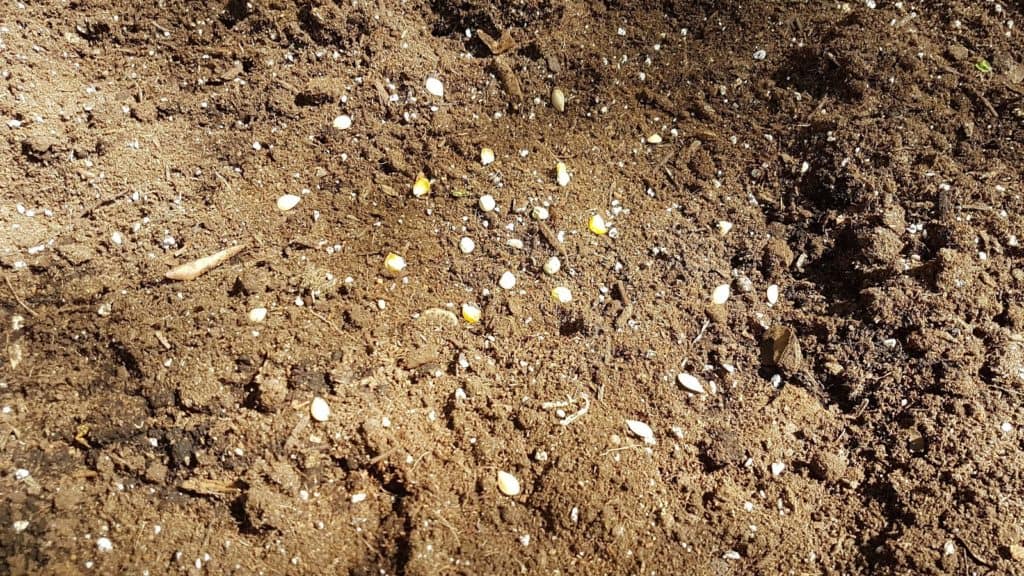
seeds in example configuration (small scale) 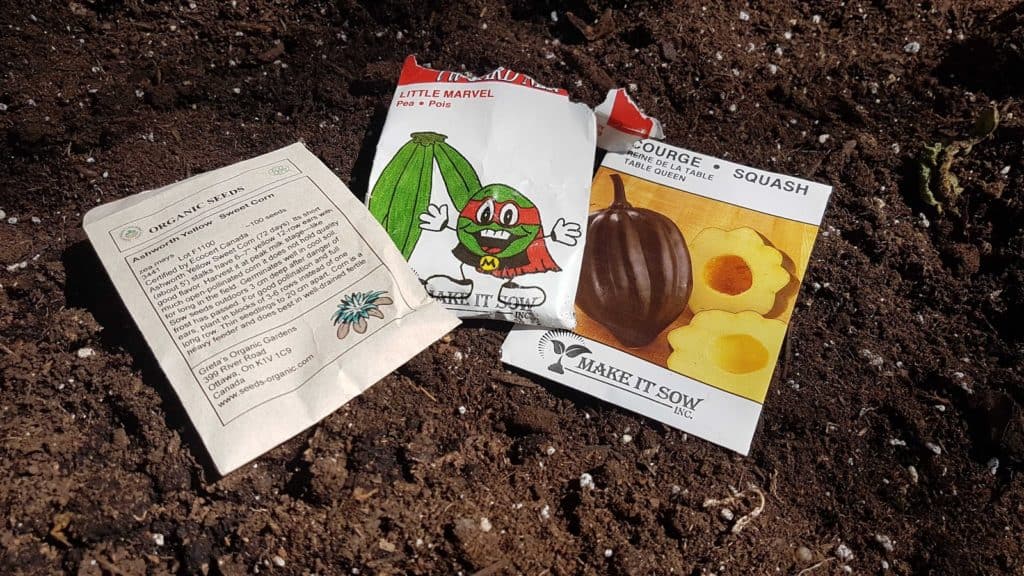
seed packaging for corn, beans, squash
Vocabulary
- Kionhekwa
- Three Sisters
- O:nenhste
- corn
- Ohsaheta
- beans
- Onon’onhsera
- squash
- Polyculture crop production
- agricultural practice of interplanting several species according to their ability to sustain one another
- Companion planting
- planting different crops in close proximity for multiple reasons
- Intercropping
- two or more crops are planted together for a specific amount of time
- Agricultural science
- the science, art and/or practice of cultivating soil, producing crops and/or raising livestock for consumption purposes
- Haudenosaunee
- translates to “people of the longhouse”; a confederacy of 5 nations including Mohawk, Seneca, Cayuga, Oneida, and Onondaga
- Heirloom seeds
- refers to the heritage of the plant; often indicates similar traits from parent-plant to child-plant
- Monoculture crop production
- agricultural practice of growing a single crop, plant or livestock in one system
- Nitrogen fixer
- plants that prevent nitrogen depletion in soil, allowing nearby plants to have an abundant supply to grow
- Mineral accumulator
- plants that reduce the need to use chemical fertilizers because they take nutrients from deep soil and bring it to the surface. The nutrients get released and used by other plants when the accumulator dies and decays
- Pest confusers
- plants that aromatically or secrete from their roots a chemical that acts as a veil to protect the primary crop from pests
- Trap crops
- plants that draw the pests from the primary crop to these more attractive trap crops so the primary crop is less affected
- Tender crops
- on the hardiness scale (fall gardening) , these crops do not survive well or tolerate frost; if exposed, damage is likely to occur
Materials
Optional:
- Corn seeds (suggested types: Oaxaca Green Dent, Black Aztek, Bear Paw, Country Gentlemen, Stowell’s Evergreen Sweet), pole bean seeds and squash seeds
- Soil
- Digital art software
Non- Computer Activity
Traditional Haudenosaunee Kionhekwa
O:nenhste (corn), ohsaheta (beans) and onon’onhsera (squash) are recognized across Indigenous nations, especially to Haudenosaunee peoples, to be a sacred and respected source of nourishment and spiritual connection.
The Three Sisters’ significance originates from the Haudenosaunee creation story. It is said that Kionhekwa are special gifts given from the daughter of the Original Woman, also known as Skywoman. When the daughter was dying during childbirth, she proclaimed that from her body would grow the food that will sustain the people. The beans emerged from her hands, the corn from her breasts and from her bellybutton grew the squash vines. Tobacco grew from her head, from her legs grew sunflowers, from her heart grew the strawberry and from her feet the original potato sprouted.
The creation story is often understood as a myth or events that occurred in the past, however, traditional knowledge and planting traditional crops tells us that Indigenous creation stories are not over. Companion planting tells us that each crop’s wellbeing is protected and watched over by that of the others. This level of cooperation and sustainability teaches us about interdependence and how we are all connected in the natural world.
The creation of these continuous relationships in a Three Sisters garden carries the creation stories forward into current day and next generations. The Original Instructions that were given to Indigenous nations of Turtle Island ensure a continuous cycle of creation and source of traditional knowledge that began with the Original Birth, provided by Skywoman.
Polyculture Crop Production
In order to understand what polyculture crop production is, it may be helpful to first understand monoculture crop production. Monoculture crop production is the agricultural practice of growing a single crop, plant or livestock in one system, therefore, polyculture is the practice of interplanting multiple species in one system (or crop rotation) to create a nutritionally self-sustaining association between plants.
Although monoculture crop production is far more practiced in modern agriculture, polyculture actually provides many benefits that monoculture does not. Polyculture is far more sustainable and beneficial to the soil and environment. Some main benefits include:
- Better soil and nutrient utilization – the soil will be used year-round and the nutrients that aren’t utilized in one crop will be beneficial to the others
- Increase in yields – crops have a higher yield because they are not as easily threatened by strong weather/environmental conditions
- Less land and water required – multiple crops can be grown on one plot of land, therefore leading to easier irrigation and less water waste
- Less pests – plants grown together are more immune to pests
- Greater soil quality – the soil properties increase when multiples crops are planted, making it more beneficial for production
- Biodiversity – the plant varieties increases the level of local biodiversity
- Meets higher food demands – less land required to produce food creates space to meet increasing demands faster
There are certain strategies that allow some of these benefits to occur. For example, for pest control, there are some plants that are called “pest confusers” and are chosen because they either aromatically or secrete from their roots a chemical that acts as a veil to protect the primary crop from pests. Another strategy for pest control is through “trap crops”, which draw the pests from the primary crop to these more attractive trap crops so the primary crop is less affected. These strategies are very beneficial as they remove the requirement of intervening through chemical pesticides that harm the Earth and water.
Soil health is greatly increased by choosing a polyculture crop production because certain plants can act as either a nitrogen fixer or mineral accumulator. Nitrogen fixers reduce the need for the land to lie fallow and prevent nitrogen depletion in soil, allowing nearby plants to have an abundant supply to grow. Mineral accumulators reduce the need to use chemical fertilizers because these plants take nutrients from deep soil and bring it to the surface. When the accumulator dies and decays, the nutrients are released and used by other plants.
Now that we know a little more about polyculture vs monoculture, let’s talk about the Three Sisters – corn, beans and squash – and why they are considered “sisters”. They are understood to be the perfect trio of companion planting because of how they interact with each other. Much like sisters, these three plants support each other by providing individually unique benefits to the others and together they create a perfect harmony of sustainable life. Corn, considered traditionally to be the eldest sister, offers much needed structural support for the beans.
The beans, known to be the giving sister, provide greater nitrogen levels to the soil and when they grow they wrap around the stalks and vines to pull the sisters closer together. Squash plants, considered the protector sister, have large leaves that provide shade to the soil to keep moisture inside to provide longer access to water and less weeds growing. Also, squash vines are equipped with tiny hairs/spikes that deter pests or predators from feeding on the sisters. All three crops play an equally significant part during their growth period and afterwards when consumed as food. Corn provides carbohydrates, beans provide protein and amino acids, and squash provides vitamins and minerals.
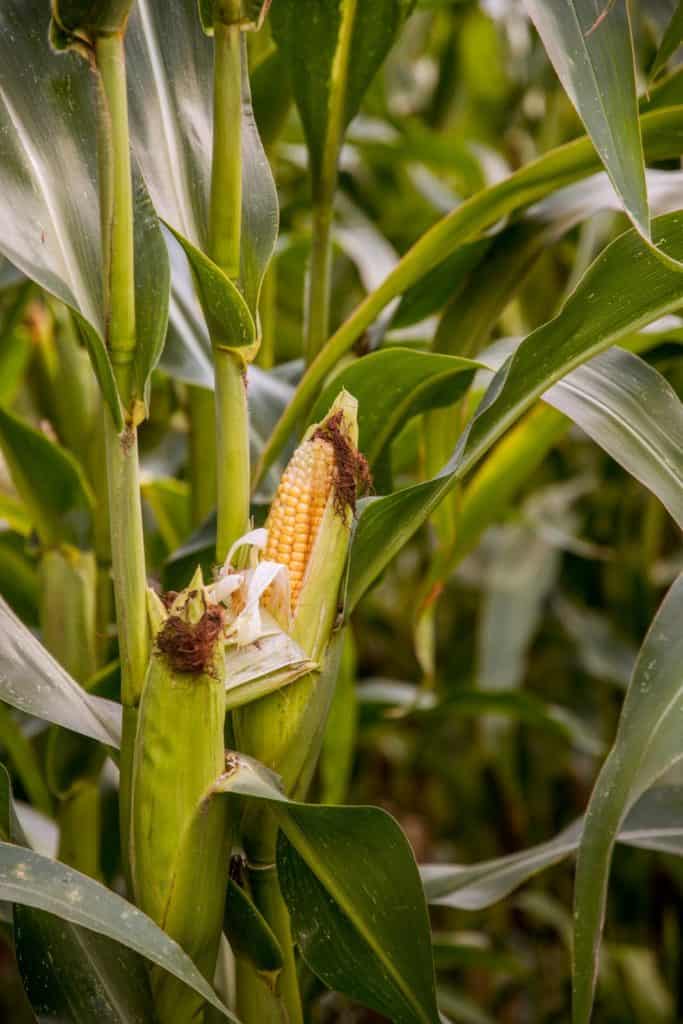
Corn 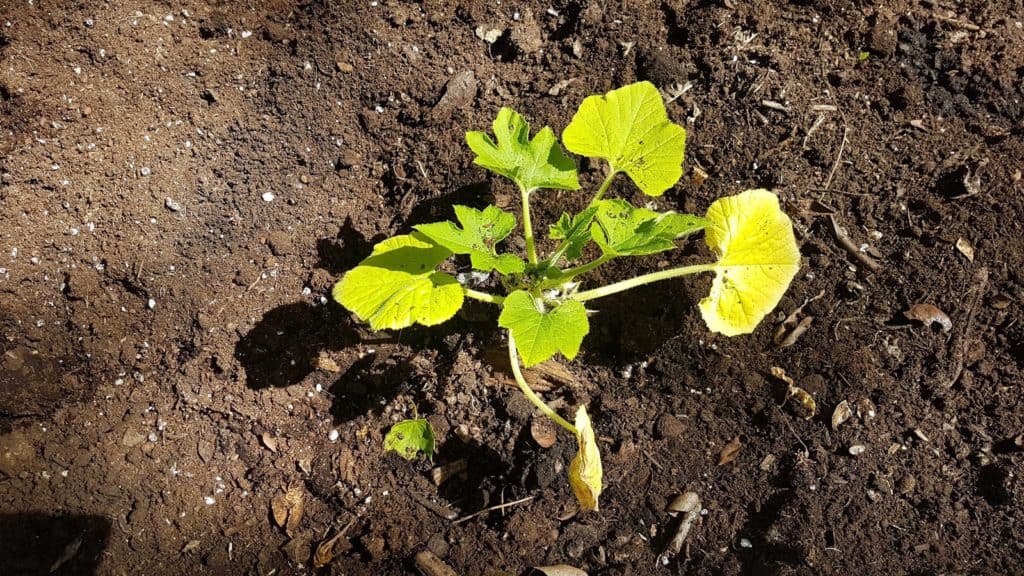
Squash 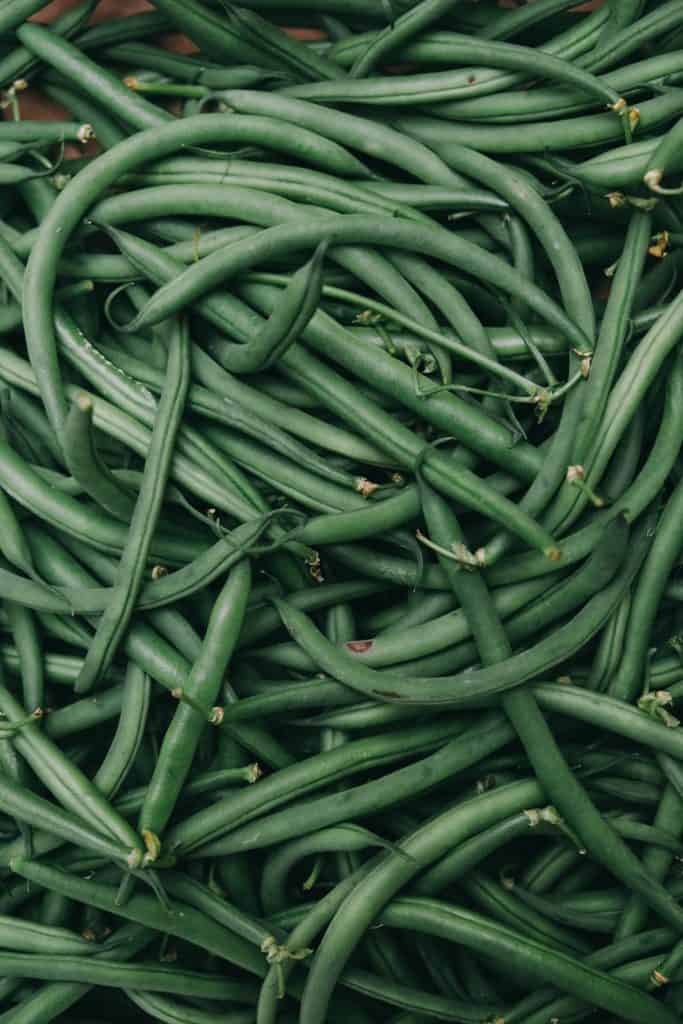
Beans
How to Plant Three Sisters Garden
Before we get started on learning how to plant a traditional Three Sisters Garden, here are some tips to consider before starting:
- Choose heirloom seeds
Heirloom varieties are more beneficial to biodiversity and contribute to the preservation and resurgence of traditional Indigenous culture, heritage and food sources - Choose a plot of land with lots of sun
- Choose vine/climbing beans, not bush beans
- Choose a corn variety that grows tall in order to support the growth of pole beans
Some varieties include: Oaxaca Green Dent, Black Aztek, Bear Paw, Country Gentlemen, Stowell’s Evergreen Sweet - Use lots of manure in the soil, as corn is known to be a heavy feeder
Fish fertilizer and wood ash are recommended - Mound the soil to one foot tall and four to five feet around to increase sunlight exposure and improve drainage
Create a small lip around the base of the crops to trap the water in and provide a more direct source to the roots and decrease soil erosion - For a larger yield, plant several mounds in staggered rows, spaced four feet apart in all directions
Traditionally, Haudenosaunee people plant the corn seeds in the north, east, south and west as a way to give thanks to the Four Directions - Grow a sunflower in the middle of the corn stalks to provide further support to the Three Sisters and encourage pollination
- Ensure you do not overcrowd your garden
- Ensure the risk of frost is zero before planting—this is very important
Each frost date will be different depending on your geographical location and general weather trend for that year. Check your local last frost date and plant afterwards. In the Kawartha Lakes and surrounding area, generally mid-to-late May is a good time to start planting. Corn, beans and squash are all considered a tender crop which means they do not tolerate frost at all. Light frost will damage these crops.
Now, let’s explore the steps to plant a Three Sisters garden. Spatial configuration and timing are two of the most important aspects to consider when planting the seeds. Note: there are many different configurations to plant a Three Sisters garden, this is one way.
- Create a large mound of soil, one foot tall and four-five feet around (diameter). Rake the top of mound into a flat bed for planting with tapered sides
- Plant the corn seeds first as they need a headstart on the other seeds. Plant six seeds, one inch deep and at least eight to ten inches apart, in a two to three foot diameter circle on top of the flat bed mound
- Once the corn grows to be six to eight inches tall, it’s time to plant the bean seeds. The bean seeds are to be planted around each corn stalk or around the entire corn circle; plant four seeds evenly spaced around the stalks, ensuring that the seeds are planted about three inches from each corn stalk.
- About a week after planting the bean seeds, it’s time to plant the squash seeds. Plant six seeds outside the corn circle with plenty of space (at least 12 inches) from the closest corn stalk, and separated widely from each other (about 18-24 inches apart). Alternatively, you can choose to plant the squash seeds on the outside perimeter of the mound to ensure adequate space for growth
- Ensure the beans grow vertically up the corn stalks instead of on the ground by physically directing the growth. Tip: using a small piece of twine to tie the two plants together will help with directional growth
- If you are planting a large yield, ensure you space the mounds apart sufficiently as some squash plants can grow approximately 10 feet in diameter
- Keep the mounds watered and weeded as needed. Keep the soil moist but not soaked during seed germination. Once the plants begin to grow larger after the first few weeks, the need for weeding will decrease
- All three plants can be harvested in the fall (September or early October). Be sure to watch your step when harvesting, as the beans and corn will mature more quickly than the squash – they like to be harvested after or close to first frost in the fall
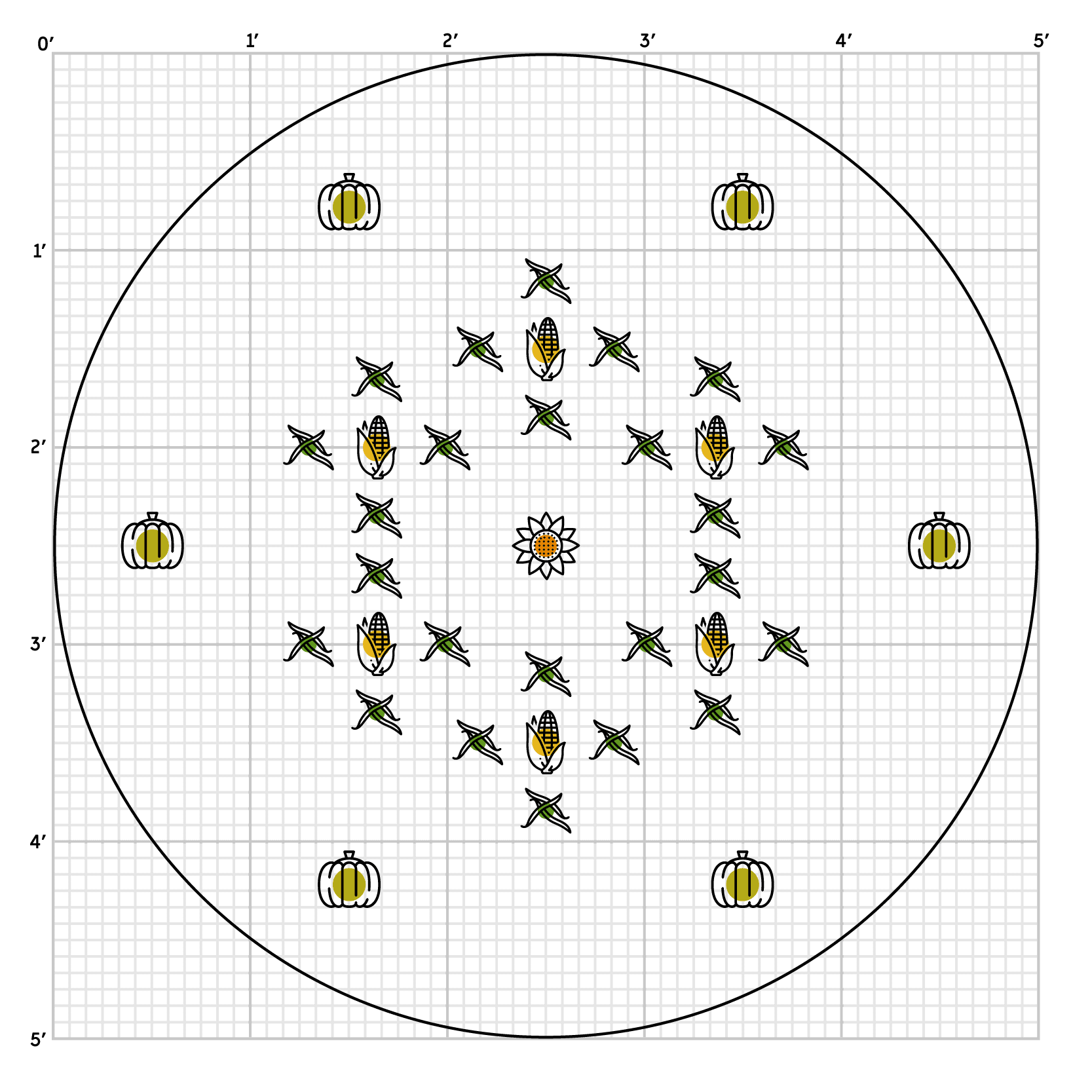
Conclusion
Recognizing that growing a traditional Kionhekwa garden may be too large of a project for some, there is still a way to show your learning from this tutorial: try creating a digital art piece of what you’d envision your garden to look like! Feel free to be as creative as you want. It could be a realistic depiction, a surrealism piece or a spiritual representation.
We want to see the awesome things you’re creating! Take a photo or video and share your work with us by emailing media@pinnguaq.com or tagging @pinnguaq on Facebook, Twitter, or Instagram. Don’t forget to include the hashtag #LearnWithPinnguaq!
Resources
Haudenosaunee creation story YouTube video.
References
- Barth, Brian. “Three Sisters Garden ” How to Plant Corn, Squash & Beans Together.” Modern Farmer, June 7, 2018.
- Folnovic, Tanja. “Polyculture Production System for Sustainable Farming.” Agrivi Blog, 0AD.
- FortWhyte Alive. “The Three Sisters Vegetable Garden.” Naturescape for Educators, August 2018.
- Hoegg, Margaret. “The Three Sisters Garden: A Sustainable Polyculture.” The Incredible Seed Company. The Incredible Seed Company, May 31, 2019.
- Kruse-Peeples, Melissa. “How to Grow a Three Sisters Garden.” Native, May 27, 2016.
- Markham, Brett L. “Mini Farming.” Google Books. Skyhorse Publishing Inc., 2010.
- Our Sustenance, Six Nations. “Three Sisters Garden.” Our Sustenance, December 19, 2018.
- Practical Plants. “Practical Plants.” Polyculture – Practical Plants, 2012.
- White, Rowen. “Three Sisters – Emergence Magazine.” Emergence Magazine, 0AD.
